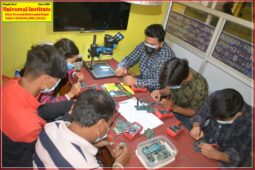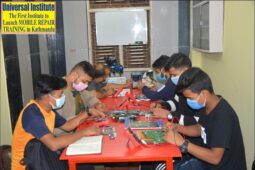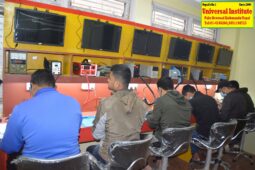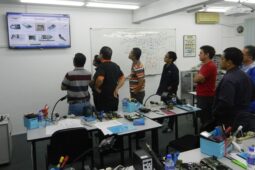Low Voltage Training in Kathmandu Nepal
Low voltage systems are comprised of electrical equipment that uses under 50 volts (V) of electricity. Common low voltages include 12volt,24 volt and 48 volt. Examples of low voltage systems include electrical, lighting, mechanical, communication, security, and fire and life safety. For Residential doorbells, home security sensors, thermostats and landscape lighting. Commercial low voltage systems cover a wide array of categories, from fire protection to security systems to sound and communication. Universal is a proven leader in the analysis, design, installation and repair service of a full range of low voltage electrical systems.
Low Voltage Training Course in Kathmandu
|
Having the right Vocational skills is vitally important in today’s competitive job market. With universal, you’re assured of learning up-to-date career technical skills that will prepare you for the jobs of today and tomorrow. You’ll learn much more than the new update latest techniques. You’ll also learn about opportunities in your chosen field and get important tips on achieving your career goals. Many of our Course also feature hands-on experience with today’s technology. The success of our students proves that universal training works. The mission is supported by an admissions policy that allows students with appropriate prior education to enroll in course without regard to religion, gender, age, national origin, or physical disability. The Institute regularly assesses fulfillment of its mission and achievement of its institutional goals through ongoing studies of student learning. |
Description of Low Voltage Course
This 3 to 6 week program prepares students for employment as a Security system installation apprentice. Student will first learn low voltage electrical theory, electrical safety and codes, safe work practices, fire safety and electrical principals & then begin planning, designing and installing CCTV, Intrusion and security alarm systems in our work labs. Various practical projects are performed in a shop environment to enhance students’ skills in lay out, assembly, installation, testing, troubleshooting and repairing security alarm systems, fixtures, control devices and related equipment in buildings and other structures.
The Low Voltage Program has been recently updated to offer a New 6 week intensive introduction course running fulltime Sunnday to Friday at Universal Institute. It provides theory and analytical training in Security system Installation & Structured Cabling Installation. The program emphasizes practical, hands-on training with the same equipment you are likely to use in your career.

Low Voltage Course Contain
1. CCTV (Closed Circuit Television)
A Closed Circuit Television (CCTV system) allows you to protect your business’s property and assets from theft and protect your employees from those who may wish to harm you. CCTV systems utilize cameras and digital recording devices to monitor activity in specific locations with images being transmitted from the camera to the recorder.
CCTV System Introduction
- Types of CCTV System – IP and ANALOG
- Selection of Camera based on Application and Location
- Design Requirement and Regulations
- Field of View and Lense Calculation
- Recording Time and Capacity Calculation
- Sample CCTV Project Design
2. Fire Alarm System
Compliant fire protection systems are critical for preserving life & property within your building. The following low voltage fire protection systems are essential components in your overall fire safety efforts:
Fire alarms: From simple single-building fire alarms to complex fire alarm networks across multiple facilities, this low voltage system ensures everyone on the premises knows to evacuate during a fire emergency.
Fire suppression systems: This automatic equipment senses when a fire is present and douses it with dry chemicals, wet chemicals, liquid, gas, or foam to put out the fire without using water. You may need a fire suppression system if you have hazardous materials or delicate equipment onsite.
Fire Alarm System Introduction
- Types of Fire Alarm System
- Design Requirement and Regulations
- Selection of Fire Alarm System
- Selection of Detector and Alarm System
- Implementation of Connectivity and System Architecture
- Designing of Fire Alarm System
- Sample Project Design.
3. Structured Cabling Networking System
Building security is vital to prevent theft and vandalism and to keep your people safe. The low voltage security systems available from State Systems include:
CCTV surveillance systems: Closed-circuit television is comprised of surveillance cameras, digital recorders, and monitors designed to keep you informed of what’s happening in and around your building. With the right network setup, you can view live and recorded footage remotely for maximum security.
Intrusion detection systems: A network of motion sensors, door and window contacts, panic switches, and other measures make your building secure against intruders. If you also have monitoring services, the police are automatically notified when these sensors activate.
Access control systems: Decide which personnel are permitted to go where with a low voltage access control system. This utilizes card readers, biometric scanners, and other means to restrict access to certain areas of your office space, hotel, hospital, apartment building, or other structure.
Structured Cabling System Intoduction
- Types of Structured Cabling System
- Design Requirement and Regulations
- Selection of Structured cabling System
- System Components, Types and Field Arrangement
- Designing of Structured cabling System
- Sample Project Design
3. Emergency Lighting System
Emergency lighting is required to illuminate building areas when things go wrong. For example, when the normal electrical supply is interrupted by a utility outage or by a fire or failure within the building. In most facilities, the largest part of emergency illumination lights the pathways and exits that lead out of the building—the egress paths. Its intent is to facilitate evacuation of the facility, particularly in the event of a fire, and to reduce the tendency of occupants to panic under stress, and in the dark.
Emergency Lighting System Introduction
- Types of Emergency Lighting System
- Design Requirement and Regulations
- Locations of Placement and Basic Consideration
- Designing of Structured Cabling Systems
- Sample Project Design
4. Access Control System
Access control systems are the electronic systems that are designed to control through a network.Access Control System recognizes authenticates and authorizes entry of a person to enter into the premise thereby giving complete protection ensuring security with the system.
Introduction to Acces Control System
- Different type of Access Control System
- Different Parts of Access Control System
- Regulation Related to Access Control System
- Selection and Design of Access Control System
- Integration with other Systems and Co ordination.
- Sample Project Design.
5. Public Addressing (Sound & Communication) System
A public address system is an electronic system comprising microphones, amplifiers, loudspeakers, and related equipment. It increases the apparent volume of a human voice, musical instrument, or other acoustic sound source or recorded sound or music.
public address system are used in any public venue that requires that an announcer, performer, etc. be sufficiently audible at a distance or over a large area. Typical applications include sports stadiums, public transportation vehicles and facilities, and live or recorded music venues and events.
Introduction of Public Addressing System
- Different Parts of Public Addressing System
- Regulation for Public Addressing System
- Selection and Design of Public Addressing System
- Audio and Video Solutions to Building Projects
- Sample Project
Why Universal Institue for Low Voltage Training?
- Provide educational programs that enable self-motivated, independent learners to acquire core competencies in their chosen technical and professional fields.
- Employ contemporary learning strategies based on academic standards of good practice.
- Develop and maintain systems that optimize student opportunities for broadly participative, interactive learning.
- Establish and communicate high standards of academic performance for students and the institution.
- Assess student learning and institutional effectiveness systematically in order to improve student performance
- Provide an extensive suite of student support services based on student needs and interests.
- Conduct fiscally responsible planning that balances the institution’s commitment to academic excellence with its concern for profitable financial performance.
Related Posts:
- Mobile Repair (Advance Chip Level)
- Computer/Laptop repair (Advance Chip Level)
- Advance Mobile Software (Full)
- TV(LCD/LED/Smart) Repair Course
- Basic Electronics & PWR Supply Course 45 days
- eMMC/UFS/Nand Training 30 days
- AC & Fridge Repair Training 60 days
- Washing Machine Repair Course-30 days
- Building Electricians(House wiring) 45 days
- CCTV Camera Opearting & Installation 45 days
- Home Appliances Repair Training 45 days
- Printer Repair (Dot-Matrix, Ink-Jak, Laser)
- Hobby Electronics Projects 45 days
- Drone Assembling Course 15 days
- Laptop Repair (Basic Card Level-1)








